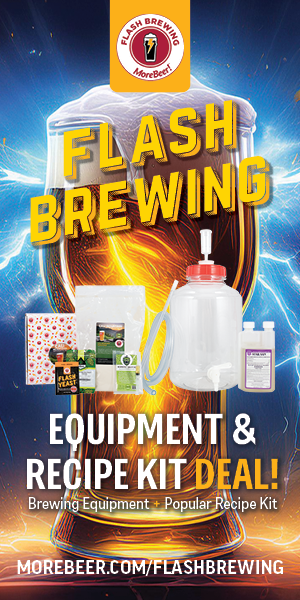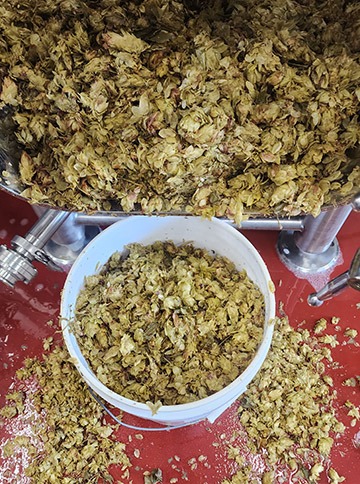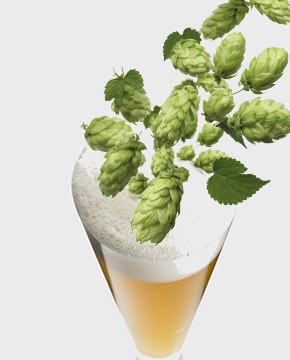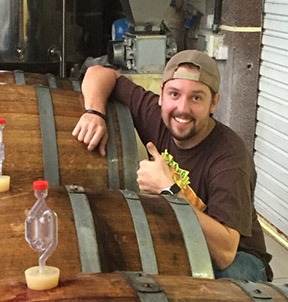First Wort Hopping Techniques
If there is one thing that symbolizes small-scale brewing in the United States, it’s hops. Some of the hoppiest beers in the world are brewed here in the States. In large part, this is because American homebrewing, and the craft-brewing wave that followed, was a reaction to the total market domination of the notoriously unhoppy American megabrews. These days, homebrewers continue to experiment with new ways of using our favorite plant’s cones. One method of using hops that is new to most homebrewers is actually an old German method called “first-wort hopping.”
In first-wort hopping, some of the bittering hops are added to the kettle along with the very first runoff from the mash. This differs from the usual homebrew practice of adding hops after the wort has begun boiling (and perhaps after the first signs of a hot break are visible). In a blind taste test cited in “Principles of Brewing Science” by George Fix (Brewer’s Publications, 1999), beer drinkers showed a preference for pilsners brewed using first-wort hopping over pilsners brewed the traditional way. Specifically, the subjects in this test — originally published in a German magazine called Brauwelt — felt that first-wort hopped beers have a more rounded bitterness and a more elegant hop nose.
Although the studies of first-wort hopping have been confined to pilsners, the same would presumably hold true for other lagers. The results for first-wort hopping of ales are less clear. Anecdotal evidence, in the form of opinions posted to online homebrewing forums, suggests that some prefer first-wort hopped ales, some don’t and some can’t tell the difference.
The Procedure
The procedure for first-wort hopping is simple. Take a portion of your bittering hops (the hops you would normally add early in the boil) and add them to the first wort that is run off from the mash. If you are an extract brewer, heat your brewing water to between 150° to 168° F. Dissolve the malt extract in this water and add your first-wort hops. Then bring the wort to a boil.
Typically between 1/4 to 1/2 of the bittering hops are used for first-wort hopping, although some brewers have used more. Using less than 1/4 will probably not make much of a difference in your finished beer. You may want to decrease the amount of hops slightly, since they will be boiled longer. Consult a hop utilization chart to see if the added boiling time will make a difference.
Begin heating the wort once there is enough to cover the bottom of the kettle, but keep the wort temperature below boiling until the entire volume is collected. The first-wort hops steep in the hot wort during the entire sparging process. For extract brewers, the hops steep as the wort is heated from temperatures in the mashing and mash-out range (150° to 168° F) to the boil.
Extract brewers may wish to heat the wort slowly, taking approximately 45 minutes to bring the wort to a boil, to match the amount of time the hops would steep in an all-grain first-wort hopped beer. Once all the wort is in the kettle, bring it (along with the first-wort hop charge) to a boil. Add the remainder of your bittering hops at the usual time and finish boiling the wort as you normally would.
Although the procedure is simple, the reasons why it produces a better beer are more complex. Although detailed research on this method is lacking, it seems that the process reduces the levels of the harsher molecules in hops while leaving levels of the desirable molecules unchanged. The mechanisms of first-wort hopping are not yet entirely clear, and some brewers believe that the benefits of this practice are questionable. You can find more information on this interesting method in Fix’s book. Better yet, you can draw your own conclusions by giving first-wort hopping a try.
The Theory of First-Wort Hopping
To discover the possible reason that first-wort hopping produces a finer bittering and more elegant aroma, you need to know about the biochemistry of hops. Hops have two classes of components that are relevant to brewing: resins and essential oils. Hop resins can be divided into hard resins and soft resins. The hard resins do not contribute much to beer flavor. The soft resins, in contrast, give beer its bitterness. The soft resins are divided into the alpha and beta fractions. There are also some uncharacterized soft resins.
Although the beta resins have some influence on beer flavor, when it comes to brewing, the most focus has been placed on the alpha resins. Hops are rated according to their alpha acid content. There are many alpha resins, or alpha acids, but the important ones are humulone, cohumulone and adhumulone. During the boil, they are isomerized into iso-alpha acids. Isomerization is a change in molecule conformation. The molecule doesn’t gain or lose any atoms or electrons, it just re-arranges them. The isomerized alpha acids are what give beer their bitterness.
Of the three alpha acids, cohumulone (in its isomerized form) gives the harshest, least pleasing bitterness. In addition, cohumulone is also the most soluble of the three alpha acids. Therefore, when you add hops to your kettle the cohumulone dissolves more quickly into the wort. Lager brewers often choose hops with a low cohumulone fraction, such as the noble hops, and may minimize late hop additions because it favors the cohumulone fraction. In a prolonged boil, some of the isomerized alpha acids may be hydrolyzed to molecules that do not impart a bitter taste.
Beers brewed with first-wort hopping have less isomerized cohumulone than beers brewed the traditional way using the same hops. Less cohumulone means the hop bitterness is more pleasing. Somehow, in the first-wort hopped beer, the levels of cohumulone get reduced. The essential oils are the second important class of compounds in hops. They can be divided into two groups, the hydrocarbons and the oxygenated fraction. There are many hydrocarbons in hops, and they vary among hop varieties. However, myrcene, caryophyllene, and humulene are the major components in most hop varieties. Analysis of first-wort hopped beers and “normal” beers showed little difference in oil retention.
There are also a variety of oxygenated oils, the most well-studied being linalool and geraniol. These oils are present in high concentration in Cascades, Columbus and other “floral” hops. These molecules are desirable components of West-Coast style pale ales, but are less favored in lagers. In contrast with the hydrocarbons, first-wort hopped beers appear to have lower levels of the oxygenated oils.
Conflicts with Traditional Homebrewing Wisdom
The practice of first-wort hopping seems to fly in the face of conventional homebrew wisdom. In homebrewing, hop charges are typically divided into bittering hops, flavor hops and aroma hops. Bittering hops are added early in the boil and are supposed to produce the bitterness in our beer. Bittering hops are usually boiled from 60 to 90 minutes. Flavor hops are added somewhat late in the boil, usually for the last 15 to 30 minutes. These hops are supposed to provide the hop flavor in the beer.
Finally, the aroma hops are added late in the boil, usually from the last 5 minutes to sometime just after the heat has been turned off. Bittering hops are usually chosen for their alpha acid levels. For bittering, many homebrewers choose high alpha hops with a low percentage of oils. Flavor and aroma hops typically have a higher oil content and lower levels of alpha acids. The reason homebrewers use separate hop charges and choose hops with different characteristics is due to our understanding of how hops are altered in the boil.
Conventional homebrew wisdom states that the oils from hops added early in the boil are all blown off in the boil. So, the oil component of bittering hops could be overlooked. This makes some sense. Immediately after the hops are added, the smell of hops is given off and this smell dissipates over time. We know that at least some hop oils are lost in the boil. But all of them? Some hop oils remain in beer even after a long boil.
Once homebrewers began choosing high alpha acid/low oil hops for bittering hops and following them up with flavor and aroma hops, the possibility of discovering that hop oils remained in beer was lost. The early-addition hops had little oils to begin with, and any aroma detected was attributed to the flavor or aroma hops. Another belief at odds with this procedure is that prolonged boiling of hops yields a coarser, less pleasurable bitterness. In first-wort hopping, the hops are boiled longer and have been steeped. Yet, pilsner drinkers in the Brauwelt study seem to prefer first-wort hopping.
Is First-Wort Hopping for Me?
Although first-wort hopping may conflict with some long-accepted practices, the study in Fix’s book shows a preference for first-wort hopped pilsners. Brewing science is still evolving, so don’t let your old homebrew book dissuade you from trying this. But what if you brew ales, as many homebrewers do? First-wort hopping reduces some of the oils expected in some styles of ale. West-Coast style pale ales, for example, would suffer if they lost their floral hop nose. Many styles of ale may not lend themselves to a more “refined” hop bitterness. Many ales demand aggressive hops that stand up to their malt and yeast flavors. This method may, however, improve summer ales, alts, or ales brewed with clean yeast and without aggressive malt or specialty grain flavors. If you brew pilsners or other lagers, you should definitely give first-wort hopping a try. The method is simple and the rewards are potentially great.
First-Word Hopped Homebrew Recipe
Here’s a recipe for a first-wort hopped beer. It’s a “pseudo-lager” interpretation of a classic American pilsner. The California lager strain exhibits lager characteristics at temperatures up to 60° F. The Wyeast 1056 loses some of its estery ale characteristics at around 65° F.
Pseudo-Pilsner
(5 gallons, all grain) OG = 1.052 FG = 1.012 IBUs = 28 or higher
Ingredients
- 7 lbs. six-row pale malt
- 1-3/4 lbs. flaked maize
- 5 AAU Northern Brewer hops (1/2 oz of 10% alpha acid)
- 4 AAU Liberty hops (1 oz of 4% alpha acid) Wyeast 2112 (California Lager) or Wyeast 1056 (American Ale)
Step by Step
Single-infusion mash at 150° F for 60 min. Add one half of both types of hops to the first-wort (2.5 AAU Northern Brewer and 2 AAU Liberty). Bring wort to boil and boil for one hour. Add remaining hops for the final 45 min. Ferment at 60° F with Wyeast 2112 (California Lager) or at 65° F with Wyeast 1056 (American Ale). Extract option: Substitute 7 lbs. unhopped liquid malt extract of the American, Canadian or Australian lager variety for the pale malt and maize. Heat water to 150° F. Dissolve malt extract and add first-wort hops. Boil wort and follow instructions above.







